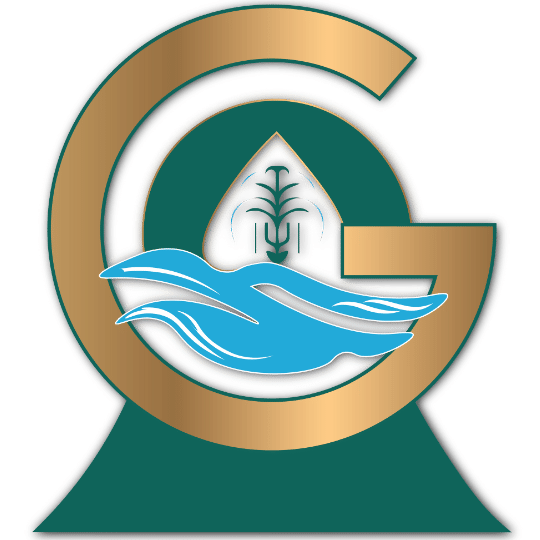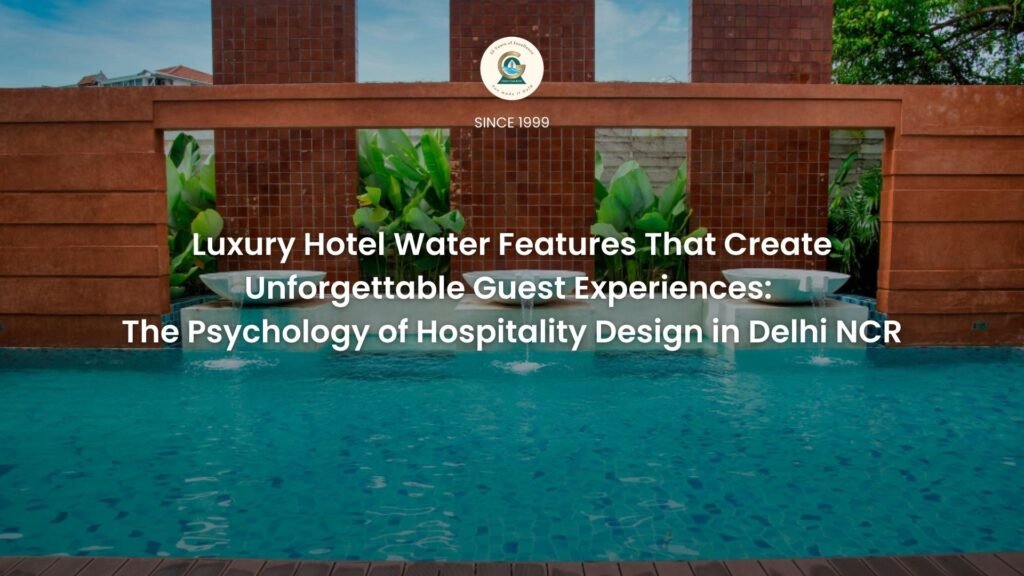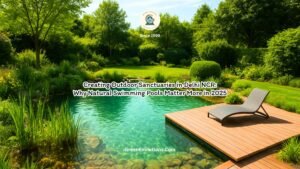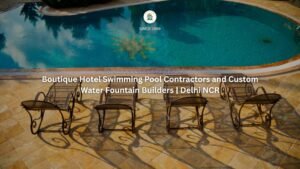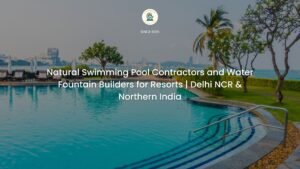Introduction: The Five-Second Decision That Determines Guest Loyalty
In the competitive luxury hospitality market of Delhi NCR, guest loyalty is determined within moments of arrival. Research in hospitality psychology reveals that visitors form lasting impressions of hotel quality within the first five seconds of entering a lobby. These split-second judgments influence not only immediate satisfaction but also likelihood of return visits, positive reviews, and word-of-mouth recommendations.
Water features play a crucial role in this critical first impression, serving as more than decorative elements – they become psychological anchors that establish the emotional tone for entire guest experiences. From the heritage properties of Lutyens’ Delhi to the contemporary luxury hotels of Aerocity, the most successful hospitality establishments understand how to leverage water’s sensory impact to create memorable, shareable, and ultimately profitable guest experiences.
Throughout this analysis, specific hotel names and details have been modified to protect client relationships while accurately representing the principles and outcomes observed in our three decades of hospitality design experience.
The Neuroscience of Hospitality Environments
Sensory Hierarchy in Guest Experience
Luxury hotel guests arrive with heightened expectations shaped by global travel experiences and social media exposure to premium properties worldwide. Creating standout impressions requires understanding the hierarchy of sensory inputs that influence guest satisfaction:
- Auditory Impact: Sound creates immediate emotional responses before visual processing is complete
- Visual Drama: Water’s movement and light interaction create dynamic focal points
- Olfactory Enhancement: Water features improve air quality and enable subtle scent integration
- Tactile Possibilities: Interactive water elements create unique engagement opportunities
- Spatial Psychology: Water defines spaces and circulation patterns subconsciously
The Instagram Effect on Hotel Design
Modern hospitality design must account for social media amplification of guest experiences. Every water feature now serves dual purposes – creating immediate guest satisfaction and generating user-generated marketing content that reaches extended networks.
A boutique property in Khan Market reported that guest-generated social media posts featuring their entrance water feature generated more booking inquiries than their professional photography. The feature’s design specifically considered photographic appeal from multiple angles, lighting conditions, and seasonal variations.
Hotel identity modified to protect confidentiality while accurately representing social media impact metrics.
Strategic Applications Across Hotel Typologies
Heritage Properties: Honoring History While Creating Contemporary Appeal
Delhi’s heritage hotels face unique challenges in balancing historical authenticity with modern guest expectations. Water features provide opportunities to enhance rather than compete with colonial architecture, creating contemporary amenities that feel historically appropriate.
We designed a courtyard water installation for a converted haveli in Old Delhi that channels traditional Islamic garden principles through contemporary engineering. The result maintains the property’s historical character while providing the sophisticated amenities expected by international guests.
The key lies in using water movement patterns and materials that complement rather than contrast with existing architectural elements. Natural stone cascades, gravity-fed systems, and traditional geometric patterns create sophisticated results that honor historical contexts.
Contemporary Luxury: Technology Integration and Smart Systems
Modern luxury hotels in areas like Cyber City and Aerocity compete with international properties by offering technologically sophisticated experiences. Water features in these environments integrate smart controls, dynamic lighting systems, and adaptive sound management that responds to occupancy patterns and ambient conditions.
One corporate hotel near IGI Airport installed a lobby water wall with programmable LED integration that reflects real-time flight information and local weather patterns. Guests report feeling more connected to their travel experience, while the hotel differentiates itself through memorable technological integration.
Boutique Properties: Creating Intimate Luxury Experiences
Boutique hotels compete with larger properties by offering personalized, intimate experiences that larger establishments cannot replicate. Water features in these environments emphasize human scale, tactile interaction, and customizable experiences.
A 30-room property in Hauz Khas Village created individual water elements for each guest room’s private terrace – small fountains that guests can control for volume and lighting. The personalization creates emotional attachment that drives repeat bookings and premium rate justification.
Climate Considerations for Delhi NCR Hospitality
Seasonal Programming and Guest Expectations
Delhi’s dramatic seasonal variations create opportunities to program water features for different guest experiences throughout the year. Summer installations emphasize cooling and refuge from heat. Winter features focus on visual drama and cozy gathering spaces. Monsoon designs celebrate the region’s relationship with water and renewal.
Successful hospitality water features adapt to these seasonal cycles while maintaining year-round visual appeal. This requires sophisticated engineering that accounts for temperature extremes, monsoon drainage, and seasonal maintenance requirements.
Air Quality Enhancement Through Water Features
Delhi’s air quality challenges create opportunities for hospitality properties to provide genuine wellness benefits through water feature design. Properly engineered installations improve local air quality through dust capture, humidity regulation, and negative ion generation.
A luxury resort on Delhi’s outskirts integrated air purification systems with their water features, creating measurably cleaner breathing environments in guest areas. Marketing this wellness benefit appeals to health-conscious travelers while providing tangible value.
Design Psychology for Different Guest Demographics
Business Travelers: Efficiency and Stress Reduction
Corporate travelers require environments that facilitate relaxation between high-stress business activities. Water features for this demographic emphasize stress reduction, phone call privacy, and transition from work to rest modes.
Business hotels near corporate centers design water features that create acoustic privacy for phone conversations while providing visual focal points that help travelers mentally disconnect from work obligations.
Leisure Travelers: Experience and Social Media Appeal
Vacation travelers seek distinctive experiences that justify premium pricing and generate memorable content. Water features for leisure properties emphasize visual drama, photographic opportunities, and unique interaction possibilities.
A family-oriented resort created an interactive water play area where children can safely engage with flowing water while parents relax nearby. The installation generates significant social media content while creating positive family memories associated with the property.
International Guests: Cultural Bridge-Building
Foreign visitors to Delhi seek authentic experiences that provide cultural insight while maintaining familiar luxury standards. Water features can bridge this gap by incorporating traditional Indian water culture elements through contemporary design and engineering.
Traditional step-well design principles, Mughal garden water channels, and regional stone materials create cultural authenticity while meeting international expectations for sophistication and reliability.
Revenue Impact and ROI Analysis
Direct Revenue Benefits
Well-designed hotel water features provide measurable revenue benefits through several mechanisms:
- Premium Rate Justification: Properties with distinctive features command 12-18% higher average daily rates
- Occupancy Rate Improvement: Memorable lobbies increase repeat booking likelihood by 25-30%
- Function Space Utilization: Wedding and event bookings increase significantly with photogenic features
- F&B Revenue Enhancement: Water features create desirable dining and cocktail spaces
Marketing and Brand Value
Water features provide ongoing marketing value that compounds over time:
- User-Generated Content: Guest social media posts provide authentic marketing reach
- Professional Photography: Features enhance all hotel marketing materials
- Media Coverage: Distinctive installations generate press coverage and industry recognition
- Brand Differentiation: Unique features help properties stand out in crowded markets
Operational Efficiency Benefits
Beyond revenue generation, water features can improve operational efficiency:
- Guest Satisfaction Scores: Higher ratings reduce marketing costs and increase direct bookings
- Staff Pride: Distinctive features improve employee satisfaction and retention
- Maintenance Synergies: Water features can integrate with HVAC and landscaping systems
- Energy Efficiency: Evapotranspiration cooling reduces air conditioning loads
Technical Requirements for Hospitality Applications
24/7 Reliability Standards
Hotel water features must operate flawlessly during peak occupancy periods, special events, and emergency situations. This demands engineering approaches that prioritize redundancy, remote monitoring, and rapid maintenance response capabilities.
Critical systems require backup pumps, emergency drainage, and fail-safe controls that prevent flooding or safety hazards. Maintenance access must allow for repairs without disrupting guest areas or creating unsightly work zones.
Water Quality and Health Compliance
Hospitality environments require water features that meet stringent health and safety regulations while maintaining visual appeal. This includes legionella prevention, chemical balance management, and regular testing protocols.
Modern installations incorporate UV sterilization, automated chemical dosing, and continuous monitoring systems that maintain water quality without visible mechanical equipment or chemical odors.
Integration with Hotel Systems
Sophisticated hotel water features integrate with broader building management systems, allowing coordination with lighting, sound, HVAC, and security systems. This integration enables features to adapt automatically to occupancy patterns, special events, and operational requirements.
Future Trends in Hospitality Water Feature Design
Sustainability and Wellness Integration
Next-generation hotel water features emphasize environmental responsibility and guest wellness. This includes rainwater harvesting, greywater integration, air purification enhancement, and biophilic design principles that reconnect guests with natural environments.
Interactive Technology and Personalization
Advanced installations will incorporate gesture control, smartphone integration, and personalized programming that adapts to individual guest preferences. This technology enhances engagement while maintaining the natural, stress-reducing benefits of water features.
Multi-Functional Integration
Future hospitality water features will serve multiple operational functions – wastewater treatment, energy generation, food production (aquaponics), and climate control – while maintaining aesthetic and experiential appeal.
Conclusion: Water as Strategic Hospitality Investment
The most successful luxury hotels in Delhi NCR understand that water features represent strategic investments in guest psychology, brand differentiation, and revenue generation. These installations create the emotional connections that transform occasional visitors into loyal advocates while generating measurable financial returns through premium pricing, increased occupancy, and reduced marketing costs.
As Delhi NCR continues developing as a global hospitality destination, properties that understand the competitive advantages of sophisticated water feature design will create guest experiences that stand out in increasingly crowded luxury markets.
The question for hospitality developers and operators isn’t whether water features provide value – it’s how to design installations that maximize both guest satisfaction and business performance while adapting to Delhi’s unique climate, cultural context, and competitive environment.
For hospitality properties considering water feature investments, success depends on understanding the intersection of guest psychology, operational requirements, and long-term financial performance. The most effective installations serve multiple strategic objectives simultaneously, creating compound value that justifies initial investment through decades of enhanced guest experiences and improved business results.
